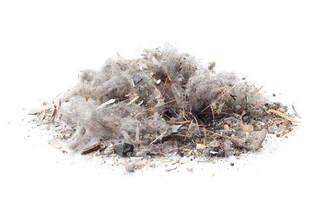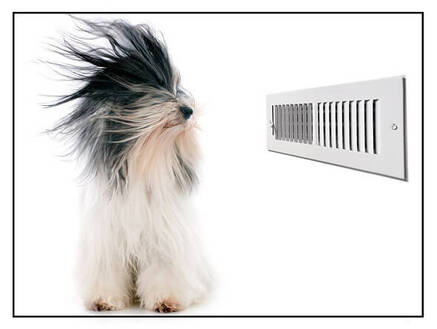|
It’s a fair question. It stands to reason that using powerful equipment to blow and suck dirt in order to move it from inside your ducts to an industrial containment off-site might result in some residual debris or airborne dust in your house. But how much is acceptable, and how much is normal? A good tech from a reputable company should do everything they can to minimize this nuisance Preliminary precautions to keep your home clean
The first thing any tech should do when entering your home is either remove their shoes or place booties over them to prevent depositing onto your floor whatever was on their soles. They’ll also likely lay down tarps to protect your flooring from the large vacuum hose that will run from their truck down to your furnace (unless they’re using portable equipment). Some technicians will up the meticulousness factor further by placing corner guards to protect wall corners from any potential damage. In order to position the vacuum hose in your main trunk line, they’ll need to cut access into it, and for this task they’ll probably use tin snips. To prevent those tiny metal shavings from falling onto your floor (ouch!), there are products, such as Chipmaster, that collect the shards before they fall. Any technician not taking this simple precaution should cleanly sweep them up. Another precaution they may take, depending on how large your home is and what level of cleaning you’ve selected, is to cover the vents with adhesive or magnetic vent covers. These aid in keeping the dust level down when each of the other vents are being serviced with the cleaning tools. The covers can also help to create extra suction power. On a smaller system (under 2500 sq ft), they may not be needed and in fact may be counterproductive because of the sheer force of the vacuum. During the service Most air duct cleanings work by utilizing the power of negative pressure. An industrial-strength vacuum is hooked into the trunk line near the furnace. Then, with the system under negative pressure, the technician services each vent, room by room, with various tools designed to move debris from the branch lines to the trunk, where it's captured by the vacuum. This negative pressure is the key component to minimizing the blow-back of debris into the house: all of the force or pressure exerted by the tools is directed toward the vacuum, increasing the negative air flow. Any vent covers placed over the registers will help in this process, both by creating more suction and by preventing debris from exiting the vents that aren't being serviced. In some cases, especially when the vents are particularly dirty, a small amount of dust from the corner of the vent will go airborne briefly in a small poof when the tool is initially engaged, usually being quickly sucked back into the system shortly thereafter. When things go wrong Things don't always go according to plan, of course, and sometimes despite the best intentions more dust than we'd like escapes the system and enters the living space. There are a few scenarios under which this could happen. In some cases when additions are constructed onto houses or retrofitting has been carried out, new vents are installed too close to the existing ones, or two vents are installed on the same branch. This unconventional installation is one of the most common reasons for dust exiting the vents during a cleaning. Excessive dust can also occur when a basic duct cleaning is performed on a system that begs for a higher-level cleaning, since large volumes of dust are present and being agitated but the tools used are insufficient to handle it all. Sometimes budget-conscious customers opt for a lower level of cleaning than needed, reasoning that a basic cleaning is better than none at all. It is arguably better to simply wait until the appropriate level of cleaning can be purchased. Finally, a cheap, ill-fitting, or bent furnace filter could easily allow dust to bypass the filter during the cleaning of the returns, causing dust to enter the supply line and escape from the supply vents. When this occurs, it is usually quickly apparent to anyone in the house, and a diligent technician will specifically check for these things before beginning the cleaning. In the event any of these problems occur, the technician should immediately halt work, investigate, correct the problem, and finally—clean up. After the fact With the proper precautions, many on the part of the tech but some (like air filter issues) on the part of the homeowner, excessive dust entering the home during routine air duct cleaning can easily be avoided. Small amounts of residual dust are normal and difficult to avoid, but large amounts of airborne debris settling onto furniture and into the carpet are not. A diligent technician will not only take precautions to prevent the accumulation of debris inside the home but will also perform any cleanup necessary. A diligent homeowner will inform the technician if they are unsatisfied with any aspect of the job, including residual debris. The cleaning company will want to be made aware of these occurrences as well, so that they can ensure technicians receive proper or additional training in this regard, and so that they can ensure the homeowner is satisfied with the final outcome. Wanna dig deeper? Download our free tipsheet: 10 Questions to Ask Before Hiring an Air Duct Cleaning Company. Download Tipsheet Many thanks to our technicians Ben S and Roy S for lending their expertise to this article.
0 Comments
Your HVAC system relies on good air flow to work its magic: heating, cooling, and ventilating your home. When your furnace is choked with dirt, your flue blocked with animal nesting, or your dryer vent clogged with lint, these systems are hindered. At best the associated system loses efficiency, at worst you risk a house fire or the backup of toxic gases into your home Let's take a look at how proper air flow affects the smooth functioning of each of the HVAC (Heating, Ventilation, and Air Conditioning) systems. We'll include the dryer venting system here, though not strictly considered part of the HVAC system. (It does feature a vent, after all, and serves to exhaust heated air outdoors.) Air flow creates draft in your chimney Your chimney relies on the process of draft to maintain combustion and to safely vent its byproducts from your home. This includes not only your fireplace flue but your furnace, water heater, and boiler flues as well. Via the process of draft, warm air and the smoke or gases it carries from the source of combustion, moves up through the flue and is exhausted outside the house, often onto the roof. Any kind of blockage or other hindrance will impede air flow and prevent draft. Without draft, of course, the necessary sequence of events will not unfold, at which point back-drafting can occur. In the case of a fireplace chimney, this will result in smoke coming back into the home rather than exiting the chimney. In the case of a utility flue (furnace, etc.), this will result in toxic gases, such as carbon monoxide, backing up dangerously into your living space. Air flow carries warm air and lint away from your dryer As your clothes dryer spins and fluffs and dries, the hot air generated by the machine is pushed out the back of the unit and through the dryer vent line, where it safely exhausts outside. Over time, as tiny bits of lint are deposited within the vent line, air flow slowly becomes restricted. Restricted air flow begets restricted air flow; that is, the more lint that is deposited, the more air flow is restricted, in turn leading to more buildup, until air flow is choked off completely by a dryer vent clog. Once a dryer vent clog has formed and air does not flow freely, several things can happen. The best-case scenario is that your dryer's efficiency is reduced and takes longer to dry clothes, or it simply shuts down. The worst-case scenario is that the heat, having no escape, builds up inside the vent line and ignites the lint, causing a fire. For this reason, no dryer vent cleaning job is considered complete until good air flow has been observed from the outside exhaust vent. Air flow through the air conditioner's A-coil transfers heat Your A-coil, or evaporator coil, is one of the indoor components of your air conditioning system. Its function, by way of a series of refrigerant-filled tubes, is to absorb heat, thus cooling your indoor air in the summer. The exterior of the A-coil consists of a series of small, tightly spaced fins that help this process. Because these fins usher air toward the coil, when they are dirty or clogged the entire process is interrupted. But the ill effects of poor air flow through the A-coil are not limited to your air conditioning system. Because all air that circulates through the HVAC system passes through the A-coil—whether it is your furnace or the AC that's running—a clogged evaporator coil has the potential to hamper not only the cooling of your home but its heating as well, and to drive up utility bills. Dirty components equal restricted air flow equals reduced efficiency equals higher energy costs. You get the picture. Air flow through the furnace generates heat Your furnace's job is to pull air from the return air ducts, warm it, and push the warmed air out through the supply ducts into your living space. Proper air flow is of course critical to this process, from beginning to end and back around again. Here are some points at which it is especially vital.
Maintain proper air flow with HVAC system cleaning If you've read this far you probably don't need convincing that proper air flow is critical to the smooth functioning of your HVAC system. Any hindrance to adequate air flow in the form of dirt or debris can create havoc and lead to equipment breakdowns. HVAC cleaning calls into action an arsenal of specialized tools (rotary brushes, air snakes, tentacled air whips, high-pressured air triggers, industrial vacuums) and technician expertise to rid the system of component-clogging dirt and debris. The result is a system that functions more smoothly and efficiently, performing its task in less time and using less energy to do so. Just as our lungs and respiratory systems need unobstructed, smooth intake and exhalation of air to function as they should, so must our HVAC systems be able to "breathe" freely in order to do their best work for us. Wanna dig deeper? Explore our HVAC cleaning service pages, including a detailed description of the cleaning process and tools utilized for each system. View HVAC Cleaning Services Many thanks to our technician Roy S. for lending his expertise to this article. |
SearchArchives
April 2022
|
Twin Cities Furnace Cleaning - Open 7 Days a Week 8AM to 8PM


